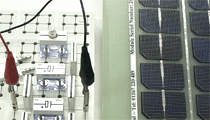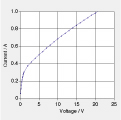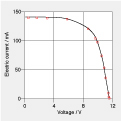a. What is the electric power of the lamp if it is hooked up to an ideal power supply at 10 V?
b. What is the resistance of the filament of the incandescent bulb for the condition stated in a?
c. The filament of the bulb is a simple metal wire which behaves like an ohmic conductor. Why is the characteristic nonlinear?
The lamp is to be hooked up to one or several PV panels. The irradiance in this case is equal to 400 W/m^2.
d. Why isn't it reasonable to hook the lamp up to a single panel?
e. You can use several panels at once. How will you arrange them in a circuit? In parallel, or in series? Why? (You only have one choice, do not mix series with parallel arrangements.)
f. If you use 7 panels in parallel, and hook up the lamp to this arrangement, what should be the voltage established across the lamp?
g. What will be the efficiency of the PV array in the case stated in f? (An array is a combination of panels.)


